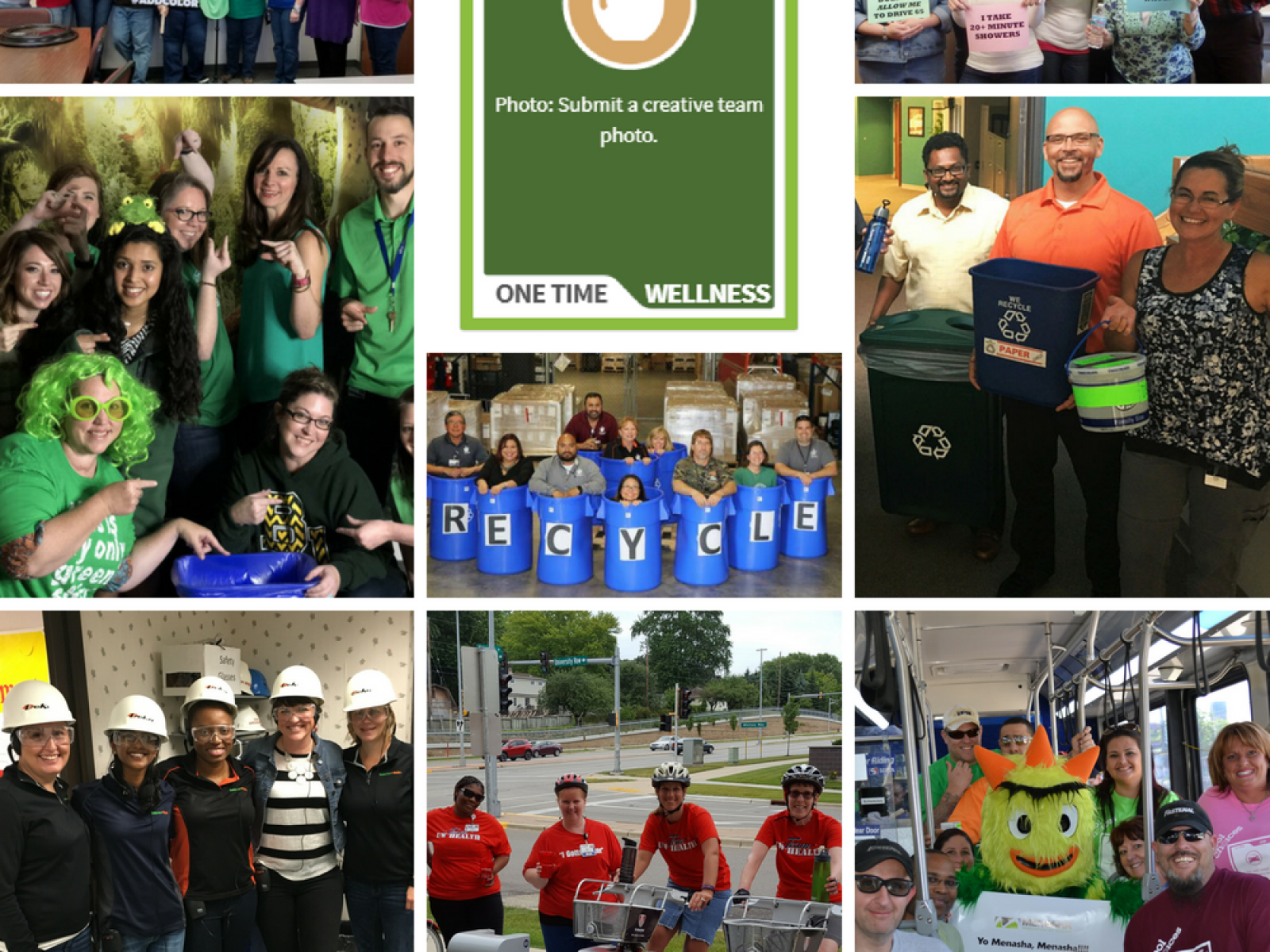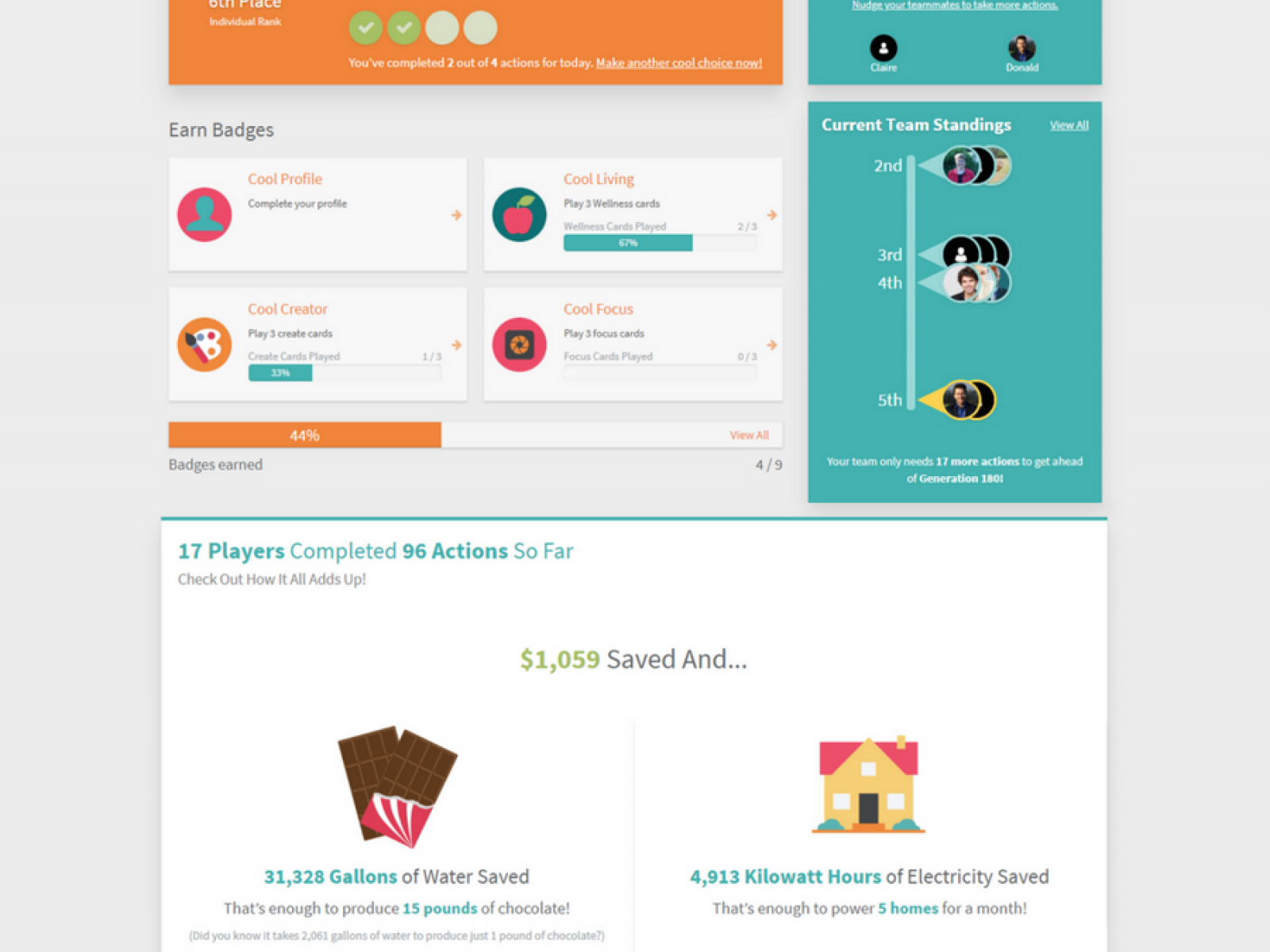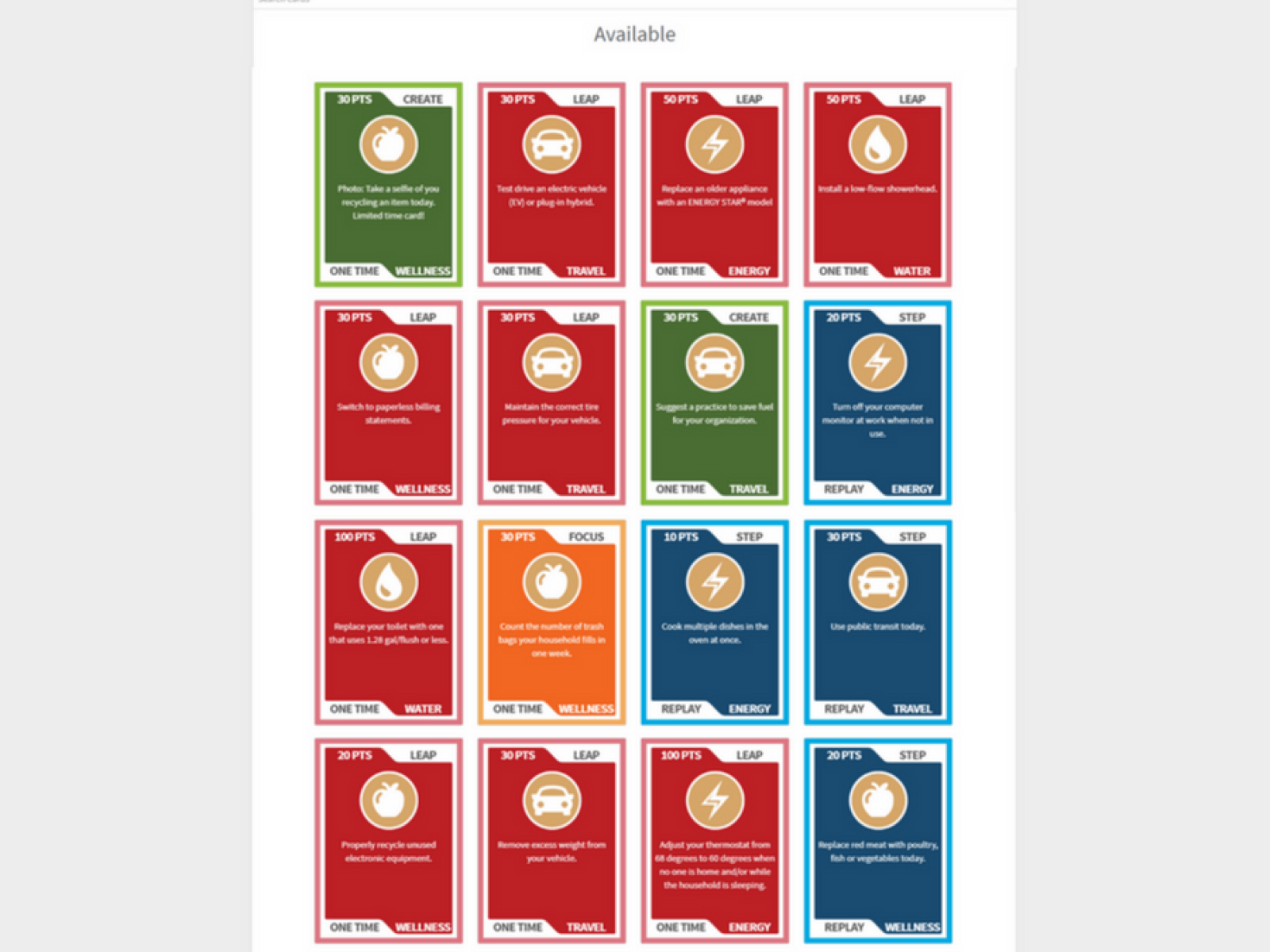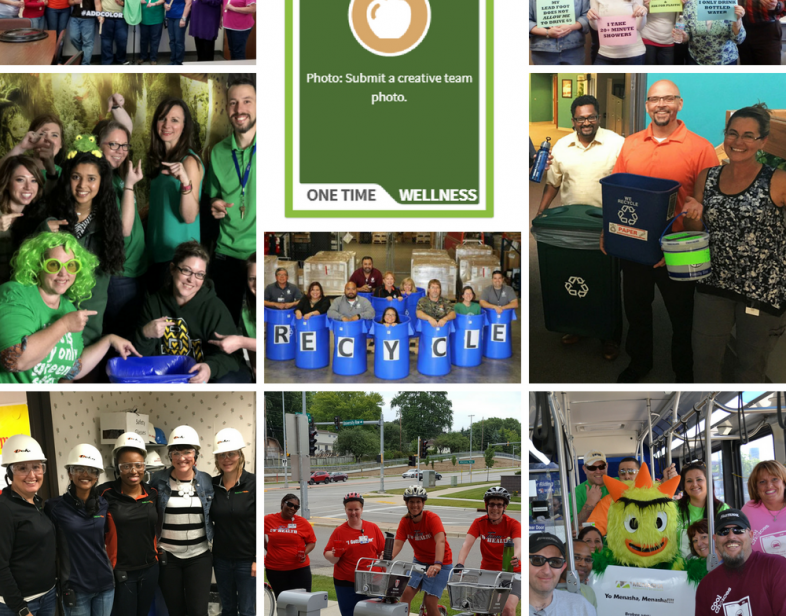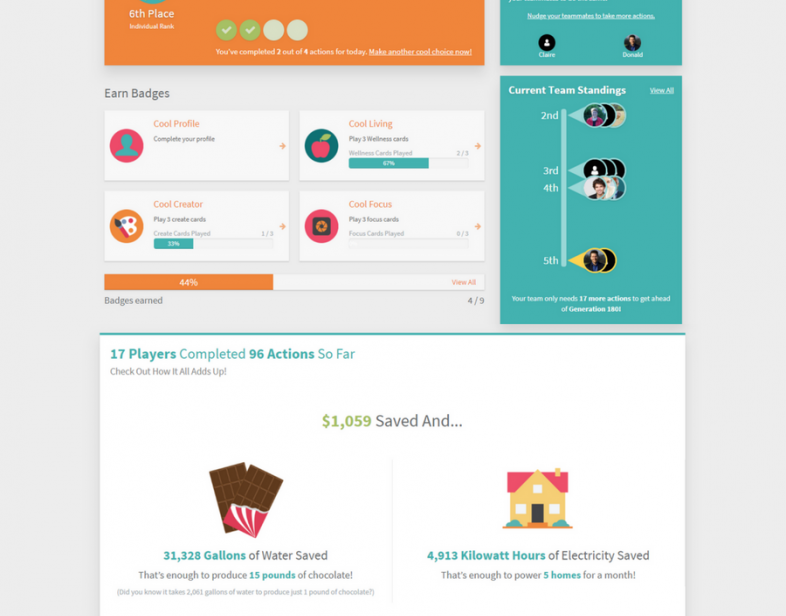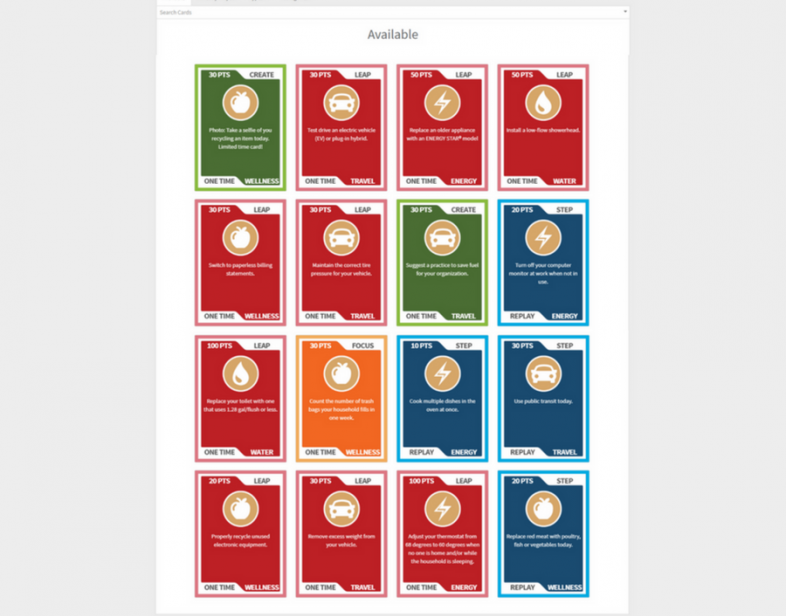An Overview Of Our Solution
Cool Choices implements an online game-based platform for businesses and communities to inspire individuals to adopt sustainable practices that save energy, water and gasoline while also reducing waste and influencing food and consumption choices at work and home. Our approach—which embeds social norms, choice architecture and the emotional appeals associated with gamification—delivers verified emission reductions while also prompting participants to talk more about sustainability and to feel more empowered about climate issues.
Our platform has delivered results with thousands of people in a variety of settings from manufacturing facilities to schools and law firms. We make it fun, social and easy for people to make cool choices and, as a result, participants adopt climate-friendly practices that endure long after the game ends.
- Population Impacted: 9,870 people to date
- Continent: North America
Context Analysis
The March 2018 Yale/George Mason Six Americas report tells us that 62% of Americans are at least “somewhat worried” about global warming but most do not think we will successfully address the challenge and 65% rarely discuss the topic with friends and family. Almost half (47%) of Americans believe global warming will harm their family but much higher percentages see risks for “future generations of people (71%) and/or plant and animal species (71%).” Lacking hope, the concern of friends or urgency, we don’t act on climate.
In addition, people don’t act because they doubt their personal actions will matter—they feel powerless. More, they fret about equity—they suspect others are wasting more, not doing their part. Finally, it can be confusing to identify what to do.
So people aren’t taking action even as emissions continue to rise. And the more we don’t act the more hopeless we feel.
Cool Choices offers a hopeful path that empowers people to be part of the solution.
Describe the technical solution you wanted the target audience to adopt
Via Cool Choices regular people adopt sustainable practices in their daily lives—they reduce energy and water use, make climate-savvy food choices, join together in their communities. We promote about 100 specific practices related to building energy use, water use, transportation, waste management, consumption and food choices. We also help participants identify and pursue climate-friendly solutions specific to their community and local priorities. We do all this via our game-based platform.
Additionally, we help participants make their sustainable practices visible in their community—they talk about what they are doing and share photos so new practices go viral.
Over time they see themselves as part of a community of people who are making good choices, choices that reduce GHG emissions and increase well-being. Peer conversations about sustainability double. Participants see that their actions, aggregated across a community, are significant. They feel empowered and hopeful.
Type of intervention
Describe your behavioral intervention
Cool Choices partners with businesses, schools and communities to inspire individuals to adopt sustainable practices. We use an online game-based platform where individuals form teams and earn points for their real-world actions. The platform makes it easy to identify what to do, fun to report your actions, and motivating to see what others are doing and how impacts add up.
Included in our platform are about 100 specific behaviors like “bike to work today” along with resource links that help participants adopt the behavior. Points signal the level of difficulty and potential for savings, a form of choice architecture.
Our approach is simple: we partner with an entity and then help their green team implement our platform, which leverages multiple behavioral insights.
Fundamental to our approach is the power of positive reinforcement. Via the game we catch people doing the right things and celebrate those actions, making action contagious to others. Playing Cool Choices feels good, creating an emotional appeal. More, we leverage social norms and organize players into teams to create additional social incentives for action. (Players can even nudge teammates to remind them to act.)
Independent third-party research confirms that participants reduce their GHG emissions 4-6%. More, participants report that they are talking about sustainability about twice as much as they did prior to the program and that their perceptions about the efforts of others have changed.
As needed, please explain the type of intervention in more detail
Using a game-based system enables us to capture participant actions while also leveraging emotional appeals (“our team is winning!”), social incentives (“look what Mary is doing”) and choice architecture (“our actions add up” and “I can earn 50 points if I…”).
Our savings estimates are rigorous: we estimate impacts using regional data for each action and we track which actions people did before the program versus new actions, so we know our incremental impacts.
By framing the effort as a game we give people the social license to coach each other, prompting increased conversations about sustainability.
We mitigate the potential for cheating by making the system transparent; players monitor each other--which generates more conversations!
Describe your implementation
Our game-based system creates a sense of urgency around adopting climate-friendly practices—because you can’t win unless you do something now. We demonstrate that individual actions matter and add up via the real-time estimated impacts players see on our dashboard. Through the leader board, photos and social stream we reinforce that others are taking action too—which makes people less complacent about their own actions. And, finally, we create a reason to talk about sustainability and climate change, typically doubling the incidence of such conversations at both work and home.
We've offered the platform to businesses since 2012. Since 2015 we’ve partnered with local entities to implement regional programs that reinforce business benefits associated with an engaged workforce. And in 2017 we implemented a program for the federal government of Singapore, demonstrating that the platform is effective on an international basis.
Every successful implementation requires a green team or sustainability lead who can lead efforts within the organization. We keep their responsibilities simple: mostly they help us recruit participants and then hand out weekly prizes for participation.
The biggest obstacle to our efforts is the cynicism of green teams. Discouraged by their past efforts to engage their peers, some green teams are convinced that their peers are apathetic and that nothing will work. These folks find it difficult to believe that a fun game can succeed where their previous information-heavy campaigns failed. Once we get people to try our platform they are hooked, often expressing regret at the time they wasted on ineffective approaches.
Key to our success is our understanding of behavioral science. From the onset we integrated insights from behavioral economics, psychology, sociology and marketing. More, we’ve partnered with academics and third-party research firms to assess our effectiveness and to help us modify the platform to achieve more impacts.
External connections
We partner with technical experts and academics both to verify our energy savings and to increase the efficacy of our model. These partners include Seventhwave, UW-Madison Psychology, Life Science Communications and Environmental Studies faculty.
At a national level we’ve joined climate collaborations, committing to reduce Cool Choices’ emissions and to help other entities reduce their emissions. Most notably, the We Are Still In coalition has listed us as a resource for businesses and other entities interested in reducing their emissions.
Since 2012 we’ve partnered with the Wisconsin Green & Healthy Schools program to make our platform available at no cost to K-12 schools in Wisconsin.
We also collaborate with the Wisconsin Sustainable Business Council, educating businesses about the benefits of engagement and the importance of changing culture relative to sustainability.
Numerous businesses have contracted with us to deliver our program to their employees. Key partners include Kohler Co., Inpro, Miron Construction, Menasha Corporation, ComEd, and UW-Health. We’ve also worked governments like the Milwaukee Fire Department and federal agencies in Singapore.
We work with public entities at a regional level to engage whole communities around sustainable practices. Key partners there include the New North, the Waukesha-Ozaukee-Washington Workforce Development Board and the City of Madison, WI. In these cases our platform reinforces local priorities.
Who adopted the desired behaviors and to what degree?
Our fun and social approach engages a broad array of participants. We attract sustainability enthusiasts, climate skeptics and high energy users. Often leaders are surprised by who joins. Our average participation rate is 25-30%. We attract the people who tend to join workplace activities, which is significant because these are the people who tend to show up—at events, at the polls and at community meetings. Their influence ripples through the broader community.
Over the course of a six-week program a typical US participant reports about 50 actions that will reduce carbon emissions by about 0.57 MeT/year. The bulk of the emission reductions come from changes to transportation (mostly around driving habits) and electricity usage.
Additionally, the rate at which participants talk about sustainability with friends, extended family and co-workers typically doubles. Coincident with these conversations is new recognition that friends and family also care about sustainability.
How did you impact natural resource use and greenhouse gas emissions?
We have regionally-calibrated savings estimates for each action and we estimate annual savings based on actions reported. We also track which actions are newly inspired versus ongoing habits to calculate the program impact. (On average participants reduce their carbon emissions 0.57 MeT annually.)
Our estimates have been calibrated via independent evaluations by Seventhwave and by Brauer et al; both entities conducted utility billing analysis with Seventhwave comparing post-game data to pre-game data and Brauer comparing post-game data to the broader population. These studies found a 4-6% reduction in household electric usage based on the program. Seventhwave also confirmed facility savings by comparing participant and non-participant fire stations. Studies are on our website.
We have also done post-game interviews with past participants to understand the persistence of actions; we found that most actions persist over time, likely due in part to the social nature of the program.
What were some of the resulting co-benefits?
In addition to reducing GHG emissions and saving money we give people an opportunity to discover the “lifestyle benefits” associated with more sustainable choices. Participants see, e.g., how spending time outside (instead of in front of screens) reduces stress and increases family bonding. Demonstrating how sustainable practices increase the quality of life can make those practices more appealing and more persistent. Being sustainable isn’t a sacrifice.
Some of our corporate partners, including Kohler Co., report that our program increases employee morale, which reinforces the corporate commitment to sustainability.
At the end of every engagement we provide companies with a list of ideas generated by their employees and companies often implement some of these ideas, further reducing emissions.
In some instances, our participants join together after the program to pursue additional projects in their community. A team in Philadelphia, for example, rehabilitated a local park.
Sustainability
While some of our efforts have been funded by foundations, the bulk of our work is market-based where businesses (or local governments) pay a fee for our services. The fee covers the direct costs associated with that program as well as some of our ongoing software development costs.
For this model to be fully sustainable we need to scale our operations so that hundreds of businesses and communities are benefitting from the platform. In recent months we have been exploring partnership opportunities that offer that level of scale. Ideally we would like to license the platform to other nonprofits around the world.
Return on investment
We have worked hard to create a platform that is easy to use at all levels. We can implement a customized program (where we create up to a dozen new actions, specific to a business’ priorities) for about $15,000. With per-participant savings of about $125/player/year, this model is cost effective for entities with less than 200 participating employees. More fully customized programs typically cost $25,000.
Cool Choices made a substantial investment in creating and testing our platform. As a nonprofit we are not trying to recoup that investment but rather to scale to a size where ongoing engagements cover the ongoing costs of maintaining and enhancing the platform.
How could we successfully replicate this solution elsewhere?
Our model is ready to scale. Cool Choices is very interested in partnerships where other entities could use the software platform to inspire change to their stakeholders.
Because our platform is easy to use, these partners will require minimal training. We’ve already implemented this model for five years with Green & Healthy Schools (GHS) to great success; in that case we train a GHS staff person to set up and manage programs for GHS schools using templates we co-created.
Scaling this more broadly, we’d envision nonprofits paying a licensing fee to use the platform. In return Cool Choices would provide the nonprofit with full access to the platform, training and support. Partners would have the ability to completely customize their set of actions or to use a set we provide. Leveraging our model will be much more cost effective than entities creating their own platforms.

